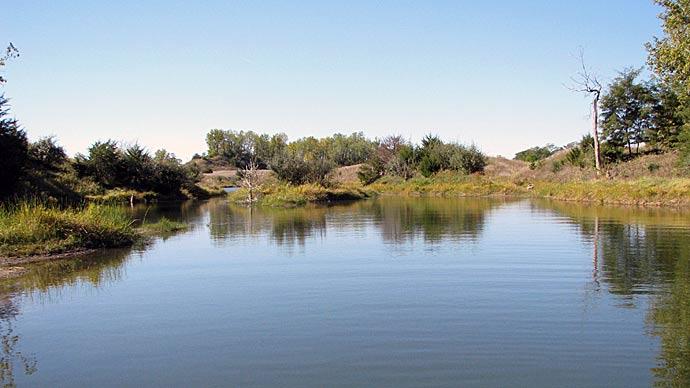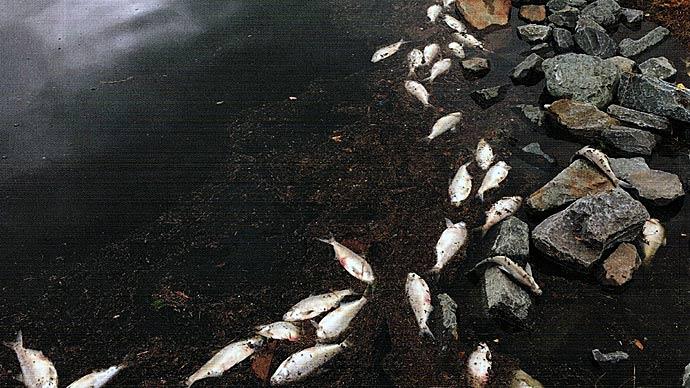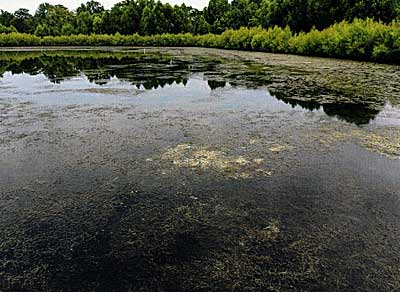
This Pondboss.com forum post started July 6. It picked up steam from the beginning because lots of people can relate to Tracy West's dilemma.
The title of the thread is, "My First Fish Kill."
Here's what Tracy wrote:
"I had a feeling it was coming because of all the excess plant life in the pond. But I can't say it was the only reason I found 16 Hybrid Striped Bass dead and floating over the past two days. Most were the larger hybrids in the pond with some going up to 7 or 8 lbs. So, here is what I think happened. First off, about 70% of the pond has vegetation in it which, I have been told, will lower dissolved oxygen at night. I increased the aeration run time from 3 to 4.5 hours running it only during night and early morning and we had three days of heavy rains with most every morning until noon and then it was cloudy the rest of the day. Looking back, I wish I had not run the aeration at all..and almost did not run it because of all the vegetation. I ran it with a very slow start up and the fish died when I increased the run times. The system had run for a week at 3 hours per night, but when I increased run time to 4.5 hours the fish died. I think it was a combination of low dissolved oxygen due to plants but when adding the diffusers run times to the pond it brought up dead water, reducing the oxygen even more, and it also increased the water temps. One thing I noticed this summer is the water temps were much cooler than other summers due to shading from the plants. So, plants, aeration, and water temperature along with several cloudy days killed off the fish. I have only found one dead Largemouth bass about two weeks ago. It was in the 4-pound range. No copper nose bluegills or redear sunfish have been seen dead and/or floating. This morning the fish were actively feeding. Brian Hoffman and I had a conversation a few weeks back about the numbers of hybrids in the pond. He thought I had too many per acre and I can't rule this out either. I continue to run the diffusers at 4.5 hours but no plans on increasing run times.
"I would suggest that anyone who has Bushy Pondweed (Southern Naiad) you need to get rid of it as soon as you first see it in the pond. In my pond it is a very aggressive-growing pondweed and grew so fast I did not realize how fast it can take over a pond. Seemed like it had taken over in just a couple of weeks. You can't kill it off in the summer because treatment can kill the fish so its pretty much mechanical removal and I'm not so sure you
can keep up with its growth. You can kill it off in very early spring using a contact herbicide. And maybe treat it in late November or early December and see if that works. Ok, I'm through venting."
As you can imagine, that thread took on a life of its own over the following month. Lots of people can empathize with Tracy and his dilemma.
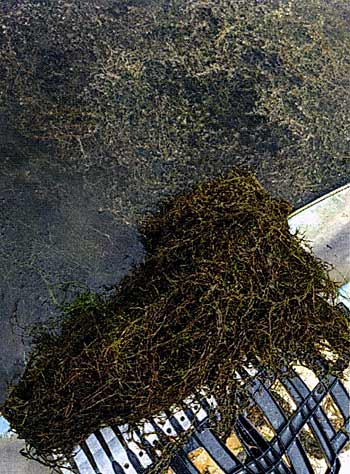
Let's do an autopsy on Tracy's pond, so to speak. He and I had a conversation to make sure the backstory was straight. His pond, not far from Caddo Lake in northeast Texas, covers about 3.1 acres. He's an avid student of pond management and has made sure his water is happy. pH is in the 7 range and alkalinity hovers around 130 parts per million. He bought a bottom diffuser aeration system, and until this year, has used it as recommended by the manufacturer. No issues with water quality. His goal was to have a healthy fishery with a legitimate shot at some trophy Largemouth bass. To shorten the growth time, he's ladder-stocked hybrid striped bass. That means he's stocked some one year, more a year later, and a few more a year later. Records indicate he's stocked around 80 hybrids as he waits for his Largemouth bass to grow. Time passed, fish have grown, and the lake record was pushing 8-pound largemouth (and hybrids maybe bigger than that). Mature bluegills are abundant.
Last year, Tracy saw bushy pondweed was becoming invasive so he called his hatchery guy for advice. His guy suggested stocking 5 triploid grass carp per acre. Tracy, an avid bass angler for decades, was fearful the fish would overeat the pondweed and strip his pond clean, so he opted to stock 10 of the cigar-shaped 10-12" fish last falL rather than the 15 recommended.
The winter was mild and the pondweed went dormant, but didn't disappear. Spring 2020 came around, Tracy prepared to start up his aeration system, bought a rebuild kit, did the maintenance, and turned on his units in mid-April. His system has 6 diffusers with two compressors. One compressor did what it does, and his bubble plumes looked good. But the other one was a different story. Nothing. He checked for leaks. Minor problem.
Keep in mind, Tracy doesn't live on his pond, and time his time at his property is limited as life must be lived. Some went by and he figured out the compressor was only operating at about 30% capacity, so he ordered another rebuild kit and did it again. This time, his system sprang to life.
Like all good pondmeisters, he did a slow start-up. By now, it was late May, coming into June. He ran it a few minutes per day, and built it up to 3 hours daily, running it mostly at night. At that point, he had anoxic water and was worried about pushing too much of it into the upper layers. Bushy pondweed was on fire, growing almost exponentially. Grass carp weren't keeping up. Tracy wondered if some of those ten fish had disappeared, probably down the gullets of his big bass.
By June, the pondweed was out of hand, covering 75% of the pond, partially by free-floating mats that had broken away and clogging deeper water.
Fish were feeding well.
Tracy was nervous. He should have been. By late June, grass carp weren't making a difference, bubble plumes weren't moving water as designed in most of the pond, his mature pond was becoming a bit overcrowded with fish, and he left his timer on to run aeration at night for those few hours. Water temperature was in the 80s, and he was afraid running the aeration system would puke up too much anoxic water into a pond with too many fish and way too much vegetation. He added those five more grass carp.
Then, early July, it happened. A freak cold front swept in and pushed against warm, moist air flowing up from the Gulf of Mexico. When that cool, dry air collided with that wet atmosphere, northeast Texas was blessed with refreshing, abundant rains uncharacteristic of that time of year.
It also shoved his pond off its precarious position.
With back-to-back rainy and otherwise cloudy days, his big plant mass did what it does. It respired. His aeration system pushed up anoxic waters, dissolved oxygen plummeted, and fish died. Without sunlight, oxygen consumption far exceeded replacement.
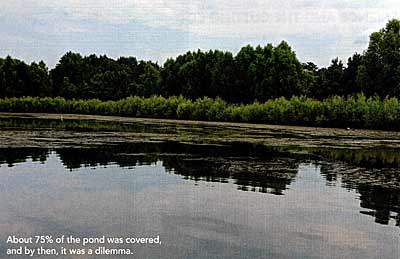
He lost most of his hybrid stripers, two Largemouth bass that were at least 8-pounds, some mature bluegills, and probably some fish he didn't see because they
were tangled several feet underwater in the plant mass.
A bunch of things came together to cause this fish kill. The elephant in the room is the explosive output of bushy pondweed. Since triploid grass carp were stocked last fall, it's safe to assume bushy pondweed was out of hand then. I've watched bushy pondweed go from zero to covering most of a pond in two years. Always remember one of the foundational tenets of pond management—As goes the habitat, so goes what lives in it. Bushy pondweed needs fairly shallow water to gain a foothold, and can grow as deep as the water is clear. If it has nutrients, the right temperature, and sunlight, it will grow. Conditions in Tracy's pond were ripe for that plant to grow. It did.
There were some basic assumptions that didn't happen as expected. By stocking ten grass carp, it was assumed they would help arrest the growth in early spring, before the plants had a chance to explode. It was also assumed the plants would subside and volume would abate over winter. With a mild winter, plants went dormant, but didn't disappear. They were poised to take over in spring. The third assumption was the aeration system would help by pushing water up, generating an upwelling of nutrients to assist in creating a plankton bloom in the spring, keeping sunlight from penetrating too deep, with visibility hopefully in the two-foot range. None of these assumptions came to light, so to speak. Grass carp, stocked in moderate numbers, couldn't get ahead, mild winter set the stage, and a warm spring pushing toward a hot summer provided perfect conditions for rapid growth. The aeration system maintenance delay rendered it almost moot, and figuring the amount of time it was running, rendered it totally moot.
Could this happen to you?
How could this scenario be avoided?
Of course, hindsight is 20-20, right? Right?
Tracy's biggest problem is that he made good decisions, based on sound logic. But like Ronald Reagan said back in the 1980s, "Trust, but verify." Tracy's sound decisions were followed by assumptions rather than by verification. Most all pondmeisters do it that way. Make choices, do the tasks, go live life. Like with many things, by the time we figure out there's a problem, we have to process it in our brains, and then decide what to do, if it isn't already so late that it's become precarious.
This one was a dogpile. Fish grew up and started reaching the carrying capacity of the pond. Few fish were harvested. The aeration system maintenance and proper startup was delayed. Pondweed wasn't investigated in spring and blew up. The pond stratified, weeds invaded, there were too many fish, and the stage was set for a correction, nature's way. Summer rain and several cloudy days pulled the trigger.
It's easy to do this autopsy, but not so easy to look back. Sure, if he'd seen the grass carp weren't going to be able to catch up and keep up, he could have applied an herbicide to keep the plants at bay. Sure, he could have harvested some fish, but their body weights exceeded 100%. Why harvest fish that look like footballs?
It all circles back to keeping our fingers on the pulse of our ponds. On-time aeration and proper operation protocol for your latitude is important. Timing is also important. Get that aeration system going earlier in the spring when water temperatures are still in the low 60s. Change protocol when water temperature rises to the low 80s. When the temps are in the mid-60s in the spring, actively look for weeds. Quantify, and then decide what to do. In this case, earlier aeration may have pushed back on the bushy pondweed by promoting a plankton bloom. Maybe not. Monitoring pondweed growth rates in early spring either verifies last fall's assumption or creates a new dilemma for a new season. That new dilemma deserves a new decision. Either stay with last fall's assumption with the grass carp, or give them a head start with some early herbicide treatments.
And, maybe eat a few fish.
Reprinted with permission from Pond Boss Magazine


